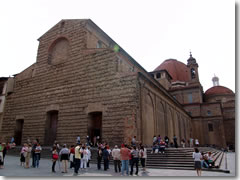
The church of San Lorenzo.The Medici's home church was designed by stellar Renaissance architect Filippo Brunelleschi (same guy who did the famous dome on the cathedral), and is decorated with works by the Medici family sculptor, the great Donatello.
Don't let the lack-of-facade fool you; there are riches within. Actually, this faceless entrance brings up a fun point.
One of the ironies of art-bedazzled Florence is that, since they always wanted the most spectacular facades for their churches, the endless series of contests pitting great artists and architects against one another to submit designs (then, oftentimes, none was picked) and a chronic lack of funds to pull off the facade they truly wanted, left most of the major churches of Florence faceless for centuries.
Both Santa Croce and the Cathedral itself only got their facades in the 19th century. Even the famously felicitous facade of Santa Maria Novella was a two-parter: the bottom half finished in the Gothic style of the 1300s; the top half not added until the early Renaissance (it is a testament to that second architect Alberti's mastery that you can barely tell the top half came more than 100 years after the fact). But the facades of Santo Spirito and, as you can see, San Lorenzo have to this day not been covered by a pretty assemblage of marbles.
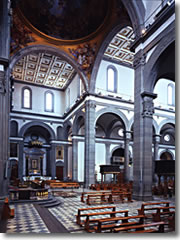
The Brunelleschian interior of the church of San Lorenzo in Florence.Santo Spirito has since been plastered over, presenting a pale yellow blank slate to its piazza (and providing a neighboring cafe with an entertainment theme, its walls covered with dozens upon dozens of framed sketches of modern suggestions for a facade).
San Lorenzo's front languishes as it has for centuries, rough brick without a public face. The original facade contest pitted Raphael against Giuliano and Antonio da Sangallo, Sansovino, and Baccio d'Agnolo. None was picked, and instead Michelangelo got the commission. He designed a lovely facade—you can still see the model he made for it in Casa Buonarotti—but it, too, never got built.
No, San Lorenzo's face has remained bare bricks since 1480. Perhaps this is why Florence hides it behind the outdoor stalls of the famed San Lorenzo leather market surrounding the church.
Everything changes on the inside, an orderly interplay of columns and arches in pale plaster outlined by dark pietra serena stone—the trademark look of its designer, the great Brunelleschi. It is a masterpiece of Renaissance architecture, and to decorate it the Medici put their famed favorite sculptor Donatello to work.
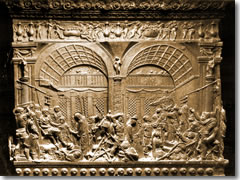
A panel from the Donatello pulpits in San LorenzoThe two pulpits flanking the end of the nave, just before it opens into the transept, were the last works Donatello ever made, cast in the early 1460s (he was probably assisted by his star pupil, Bertoldo—who would go on to teach a teenaged Michelangelo how to carve marble).
These scenes are crowded and complex, with a marvelous usage of foreshortening and schiacciato relief—the lines oftentimes barely scratched into the bronze, yet their design able to simulate the illusion of great depth.
(Donatello pioneered this technique, which was borrowed by painters like Paolo Uccello and Masaccio—see Santa Maria Novella—to create linear perspective on totally flat surfaces in their frescoes, revolutionizing art forever.)
The panels on each pulpit bear closer scrutiny. Shame they're usually so poorly lit. Bring binoculars.
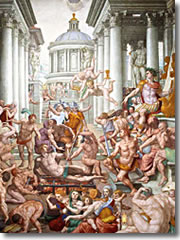
Bronzino's Martyrdom of St. Lawrence.Against the end of the left aisle wall is a large fresco by Bronzino of The Martyrdom of St. Lawrence. San Lorenzo's titular saint was a deacon of the church in the 3rd century—and, as it turns out, cooler than James Dean, Marlon Brando, and Cool Hand Luke put together.
Just after Pope Sixtus II was arrested and executed during the wave persecution by the emperor Valerian (ushering in the year without a pope in AD 258/259), Lawrence was brought before the authorities. They demanded that he return in three days to hand over all the wealth of his church.
Lawrence spent his borrowed time distributing as much of the church's treasures as possible among the Christians of Rome (though he secretly sent his most prized possession back to his parents in Aragon, Spain, to hide it: the cup used by Christ and his disciples at the Last Supper—the cup known to history as the Holy Grail).
When Lawrence appeared back before the Roman authorities, rather than a treasure train he was accompanied by a vast crowd of the poor, beggars, and cripples of the city.
"Here is my church's treasure," he said. "And it is far richer than that of your emperor."
Valerian was not amused.
For his act of defiance, Lawrence was swiftly sentenced to death—a death by roasting. They threw him onto a vast gridiron over a hot fire, where he slowly burned to death. But Lawrence never screamed, and he never cried out. Legend has that a Roman soldier, trying to taunt him into tears, mockingly asked the martyree how he was doing. Through gritted teeth, Lawrence spat out, "Turn my over. I'm done on this side."
OK, I try not to use curse words on this site, but I don't care who you are: that's just badass.
It also helped make St. Lawrence the patron saint of chefs and roasters—and, naturally, of comedians.
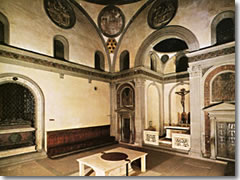
The Sagrestia Vecchia (Old Sacristy) of San Lorenzo church in Florence, designed by Brunelleschi and decorated by Donatello.Just around the corner, in a chapel off the left transept, is a Annunciation by Filippo Lippi and a monument to Donatello, who is buried in the crypt below (alongside his lifelong patron, Cosimo Il Vecchio de' Medici).
But the real draw in this corner of the church is through a doorway on the far side of the left transept leading into the Sagrestia Vecchia (Old Sacristy).
This is pure Brunelleschi architecture at its finest, rivaled only perhaps by the Pazzi Chapel in Santa Croce. Donatello chipped in with the decorative elements, including the tondi (round panels) in the corners and above the arches, crafted of terracotta and plaster and remarkably preserved. The terracotta bust of San Lorenzo is by either Donatello or Desiderio da Settignano; the bronze panels on the doors are likely by Michelozzo.
The Old Sacristy was commissioned by Giovanni de' Bicci di Medici—the founder of the Medici bank and, hence, the family's subsequent fortunes—and he is buried here along with his grandsons, Giovanni and Piero de' Medici (son of the great civic leader Cosimo Il Vecchio and father of Lorenzo "the Magnificent"), in a tomb by Verrocchio.
(Incidentally; it's only called the "Old Sacristy" because a generation later Michelangelo designed a "New Sacristy" off the right transept to serve as a tomb for the next generation of Medici, Lorenzo Il Magnifico and his heirs and cousins. Unfortunately, this room—adorned by Michelangelo statues—is only accessible via the Chapel of the Princes, which may be physically located right behind San Lorenzo's main altar, but the entrance to which is outside and around the back of the church—with, of course, a separate admission fee.)
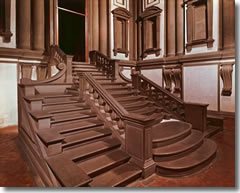
The staircase to the Laurentian LibraryOff the cloisters adjacent to the church is the Biblioteca Medicea Laurenziana (the Laurentian Library), a wonderful example of Michelangelo's felicitous and playful architecture.
The sweeping, dignified staircase he designed—leading up to the cozy, low-ceiling reading room and wedged into a tight vestibule the looks like a small building turned inside-out—would influence the concept of grand interior staircases for centuries to come in palaces across Europe.
Piazza S. Lorenzo
tel. +39-055-264-5184 or +39-055-214-042
insignebasilicasanlorenzo.wordpress.com
Mon–Sat 10am–5pm
Sun 1:30–5:30pm Mar–Oct (closed Sun in winter)
Laurentian Library: Mon, Wed, Fri: 8am–2pm; Tues and Thurs: 8am–5:30pm (closed Sept 1–15)
Basillica: €6
Basillica and Medicea Laurenziana Library: €8.50
With Firenze Card: Free
Bus: C1; 14, 23
Hop-on/hop-off: Stazione FS SMN (A,B), Piazza Stazione (C)
Planning your day: Give the church itself about half an hour, plus another 20 minutes for the library. Plan to be here in the morning so you don't miss the library, which is closed in the afternoons. (Plus, the shopping in the surrounding market is better in the morning.).
Again, the Medici are actually buried in three places in the church complex; the crypt below the church (open rarely) where Cosimo il Vecchio, founder of the Medici dynasty's fortunes, rests in peace (alongside his favorite sculptor, Donatello); the Old Sacristy we talked about above, with Cosimo's parents and sons; and the totally separate "Chapel of the Princes and New Sacristy (ornate tombs of the later Medici, plus some nifty Michelangelo sculptures decorating the tombs of Cosimo's famous grandson Lorenzo "The Magnificent" de' Medici and his heirs and cousins).
Even though this last part is technically a party of the church fabric—the Chapel of the Princes rotunda is directly behind the altar, and the "New Sacristy" with those Michelangelo-designed tombs is actually in the same spot off the right transept as the Old Sacristy is off the left transept, balancing things out nicely—entry to all of this sector is blocked off from inside the church.
You have to exit San Lorenzo, turn left to walk outside along its flank through the market stalls around to the back of the church—and then, of course, pay a separate admission fee. » more
Take a guided tour of Chiesa di San Lorenzo with one of our partners:
You can attend mass: Sundays at 9:30am, 11am, and 6pm; Mon–Fri at 9:30am and 6pm; Sat at 6pm. For more info: insignebasilicasanlorenzo.wordpress.com
Share this page
Search ReidsItaly.com
Piazza S. Lorenzo
tel. +39-055-264-5184 or+39-055-214-042
www.operamedicealaurenziana.it
Mon–Sat 10am–5pm
Sun 1:30–5:30pm Mar–Oct (closed Sun in winter)
Laurentian Library: Mon, Wed, Fri: 8am–2pm; Tues and Thurs: 8am–5:30pm (closed Sept 1–15)
Basillica: €6
Basillica and Medicea Laurenziana Library: €8.50
With Firenze Card: Free
Bus: C1; 14, 23
Hop-on/hop-off: Stazione FS SMN (A,B), Piazza Stazione (C)